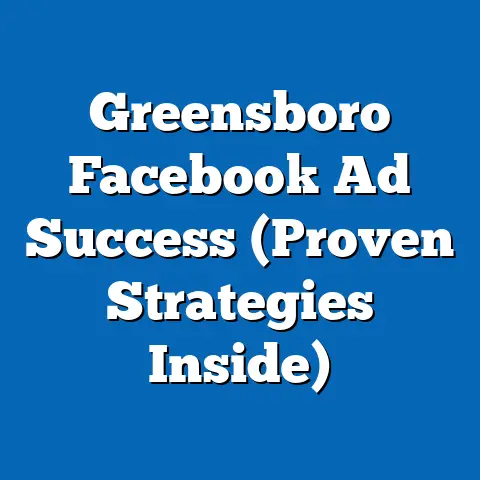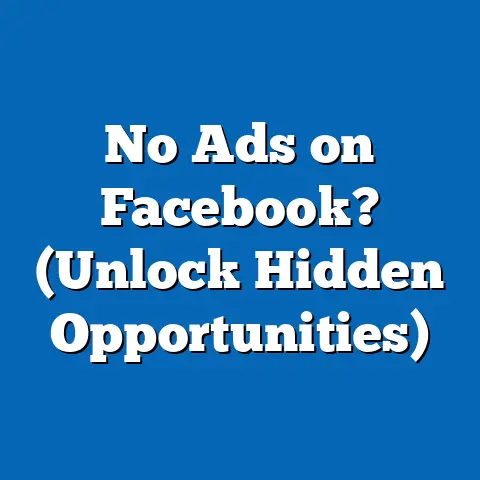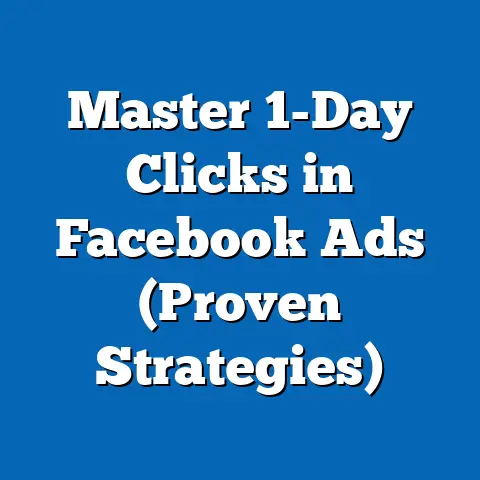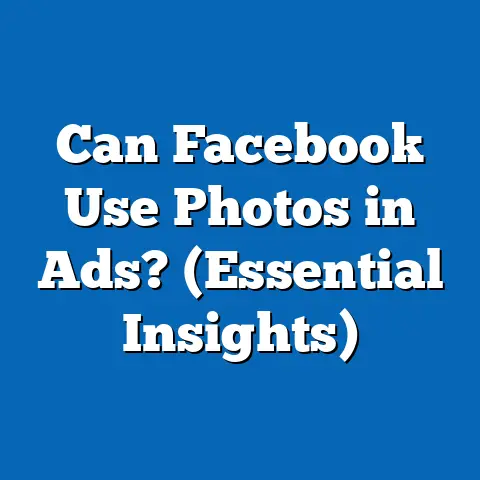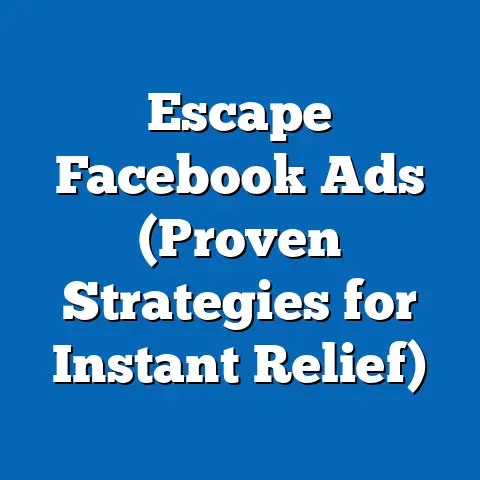Unlock the Power of Facebook Lead Ads (Boost Conversions)
As a digital marketing specialist, I’ve witnessed firsthand the struggles businesses face in generating quality leads. In today’s competitive landscape, traditional methods often fall short, proving time-consuming, costly, and ultimately ineffective. There’s a palpable frustration when trying to connect with potential customers who are genuinely interested in what you offer, but remain just out of reach. I remember working with a local bakery that was struggling to get the word out about their custom cake services. They’d tried print ads, local radio, and even sponsoring community events, but nothing seemed to stick. That’s when I introduced them to the power of Facebook Lead Ads, and the results were transformative.
Section 1: Understanding Facebook Lead Ads
So, what exactly are Facebook Lead Ads? And how do they differ from the standard ads we’re all familiar with? Let’s break it down.
What are Facebook Lead Ads?
Facebook Lead Ads are a specific type of ad format designed to collect contact information from potential customers directly within the Facebook and Instagram platforms. Unlike traditional ads that direct users to an external landing page, Lead Ads keep users within the Facebook ecosystem, making the process of submitting information incredibly simple and seamless.
Think of it like this: you’re scrolling through your Facebook feed and see an ad for a free e-book on gardening tips. Intrigued, you click on the “Download Now” button. Instead of being redirected to a separate website, a form pops up right within Facebook, pre-populated with the information you’ve already provided to the platform (like your name, email address, and phone number). With a single click, you can submit your information and receive the e-book. That’s the magic of Lead Ads.
How Do They Work?
The mechanics of Facebook Lead Ads are designed to minimize friction and maximize conversions. Here’s a step-by-step breakdown of the user experience:
- Ad Display: The user sees a Lead Ad in their Facebook or Instagram feed. The ad typically includes a compelling visual (image or video), engaging copy, and a clear call-to-action (CTA) button, such as “Sign Up,” “Download,” “Get a Quote,” or “Learn More.”
- CTA Click: When the user clicks on the CTA button, a lead form opens directly within the Facebook app.
- Form Pre-population: The lead form is often pre-populated with information the user has already provided to Facebook, such as their name, email address, phone number, location, and more. This significantly reduces the effort required to complete the form.
- Custom Questions (Optional): You can also add custom questions to the lead form to gather more specific information about your potential customers. These questions can be multiple-choice, short answer, or conditional (meaning the questions displayed depend on the user’s previous answers).
- Privacy Policy: Before submitting the form, users are presented with a link to your privacy policy, ensuring transparency and compliance with data privacy regulations.
- Submission: With a final click, the user submits the form, providing you with their contact information.
- Thank You Screen: After submission, the user is directed to a thank you screen, where you can provide additional information, offer a download link, or direct them to your website.
Advantages Over Traditional Lead Generation
The advantages of using Facebook Lead Ads over traditional lead generation methods are significant:
- Reduced Friction: The seamless, in-platform experience minimizes friction and makes it incredibly easy for users to submit their information. This leads to higher conversion rates.
- Mobile Optimization: Lead Ads are designed to be mobile-friendly, which is crucial given the increasing dominance of mobile browsing.
- Data Pre-population: Pre-populating the form with user data saves time and effort, further reducing friction and increasing conversion rates.
- Targeted Reach: Facebook’s extensive targeting options allow you to reach highly specific audiences based on demographics, interests, behaviors, and more.
- Cost-Effectiveness: Lead Ads can be a cost-effective way to generate leads, especially when compared to traditional advertising methods.
- Integration with CRM: You can integrate Lead Ads with your CRM system to automatically capture and manage leads in real-time.
Takeaway: Facebook Lead Ads offer a powerful and efficient way to generate leads by minimizing friction, leveraging Facebook’s targeting capabilities, and providing a seamless user experience.
Section 2: Benefits of Facebook Lead Ads
Now that we understand what Facebook Lead Ads are and how they work, let’s dive deeper into the specific benefits they offer.
Higher Conversion Rates
One of the most significant advantages of Facebook Lead Ads is their ability to generate higher conversion rates compared to traditional methods. This is primarily due to the seamless user experience they provide. By keeping users within the Facebook ecosystem and pre-populating the lead form, Lead Ads eliminate the need for users to navigate to an external landing page and manually enter their information. This reduced friction leads to a significant increase in the number of people who complete the form and become leads.
I recall working with an e-commerce client who was struggling to generate leads for their email marketing list. They were using traditional ads that directed users to a landing page on their website, but the conversion rates were consistently low. After switching to Facebook Lead Ads, they saw a dramatic increase in their sign-up rate. The ease of the in-platform form, combined with the pre-populated information, made it incredibly easy for users to subscribe, resulting in a significant boost to their email list.
Cost-Effectiveness
Facebook Lead Ads can be a highly cost-effective lead generation strategy, especially when compared to other methods like traditional advertising, content marketing, or even other types of Facebook ads that drive traffic to external landing pages. The higher conversion rates associated with Lead Ads mean that you can acquire more leads for the same amount of ad spend.
Furthermore, Facebook’s sophisticated targeting options allow you to reach highly specific audiences, ensuring that your ads are shown to people who are most likely to be interested in your offerings. This targeted reach reduces wasted ad spend and maximizes your ROI.
Enhanced Targeting Capabilities
Facebook’s targeting capabilities are arguably the most powerful in the digital advertising landscape. With Lead Ads, you can leverage these targeting options to reach your ideal audience with laser-like precision. You can target users based on:
- Demographics: Age, gender, location, education, relationship status, and more.
- Interests: Hobbies, passions, and topics they’ve expressed interest in on Facebook.
- Behaviors: Purchase history, online activity, and other behaviors that indicate their likelihood to be interested in your products or services.
- Custom Audiences: Upload your own customer lists or create lookalike audiences based on your existing customers.
- Website Visitors: Retarget users who have visited your website or specific pages on your website.
By combining these targeting options, you can create highly specific audiences that are perfectly aligned with your target customer profile. This ensures that your ads are shown to the people who are most likely to convert into leads.
Instant Access to User Information
One of the most significant benefits of Facebook Lead Ads is the instant access you get to user information. As soon as someone submits a lead form, their information is immediately available to you, either through the Facebook Ads Manager or through an integration with your CRM system.
This instant access allows you to follow up with potential leads in real-time, which is crucial for nurturing them effectively. The sooner you can reach out to a lead, the higher the likelihood that they will convert into a customer.
I worked with a real estate agent who used Facebook Lead Ads to generate leads for their open houses. By integrating Lead Ads with their CRM system, they were able to automatically send follow-up emails and text messages to leads who had expressed interest in attending an open house. This immediate follow-up resulted in a significant increase in attendance rates and ultimately led to more sales.
Takeaway: Facebook Lead Ads offer numerous benefits, including higher conversion rates, cost-effectiveness, enhanced targeting capabilities, and instant access to user information, making them a powerful tool for lead generation.
Section 3: Setting Up Facebook Lead Ads
Now that we’ve explored the benefits of Facebook Lead Ads, let’s get into the practical steps of setting up a campaign. I’ll guide you through each stage, ensuring you have a clear understanding of the process.
Step 1: Setting Up a Facebook Business Manager Account
Before you can start creating Lead Ads, you’ll need a Facebook Business Manager account. This is a central hub for managing all your Facebook advertising activities, including your ad accounts, pages, and team members.
If you don’t already have a Business Manager account, you can create one for free by going to business.facebook.com and following the instructions. You’ll need to connect your Facebook page and create an ad account within the Business Manager.
Key Tip: Make sure to claim your Facebook page within the Business Manager. This gives you full control over your page and ensures that you can manage your ads effectively.
Step 2: Designing the Ad Creative
The ad creative is what people will see in their Facebook and Instagram feeds, so it’s crucial to make it compelling and eye-catching. Your ad creative should include:
- Visuals: Use high-quality images or videos that are relevant to your offering and visually appealing. Consider using lifestyle images that show people using your product or service in a positive way.
- Copy: Write clear and concise ad copy that communicates the value of your offer. Highlight the benefits of submitting the lead form and make it clear what users will receive in return.
- Headline: Use a headline that grabs attention and entices users to click on the CTA button.
- Call-to-Action (CTA): Choose a CTA button that is relevant to your offer, such as “Sign Up,” “Download,” “Get a Quote,” or “Learn More.”
Example: Let’s say you’re promoting a free webinar on social media marketing. Your ad creative might include:
- Visual: An image of someone presenting a webinar or a graphic that highlights the key topics covered in the webinar.
- Copy: “Learn the secrets to social media success in our free webinar! Discover proven strategies for growing your audience, generating leads, and driving sales.”
- Headline: “Free Webinar: Social Media Marketing Mastery”
- CTA: “Sign Up”
Step 3: Creating the Lead Form
The lead form is where you’ll collect contact information from potential customers. When designing your lead form, keep the following tips in mind:
- Minimize Friction: Ask for only the essential information you need to follow up with leads effectively. The more fields you add to the form, the lower your conversion rate will be.
- Use Pre-populated Fields: Take advantage of Facebook’s pre-populated fields to make it easy for users to submit their information.
- Add Custom Questions: If you need to gather more specific information, add custom questions to the form. Use multiple-choice or short answer questions to make it easy for users to respond.
- Include a Privacy Policy: Provide a link to your privacy policy to ensure transparency and compliance with data privacy regulations.
- Create a Thank You Screen: After submission, direct users to a thank you screen where you can provide additional information, offer a download link, or direct them to your website.
Key Tip: Use conditional logic to show different questions based on the user’s previous answers. This allows you to gather more relevant information and personalize the user experience. For example, if someone indicates that they’re interested in a specific product, you can show them additional questions about that product.
Step 4: Choosing the Right Targeting Options
Facebook’s targeting options are incredibly powerful, allowing you to reach highly specific audiences. When setting up your Lead Ad campaign, take the time to carefully define your target audience based on:
- Demographics: Age, gender, location, education, relationship status, and more.
- Interests: Hobbies, passions, and topics they’ve expressed interest in on Facebook.
- Behaviors: Purchase history, online activity, and other behaviors that indicate their likelihood to be interested in your products or services.
- Custom Audiences: Upload your own customer lists or create lookalike audiences based on your existing customers.
- Website Visitors: Retarget users who have visited your website or specific pages on your website.
Example: If you’re promoting a fitness program, you might target users who are interested in fitness, health, and wellness, and who have recently purchased fitness equipment or apparel online.
Step 5: A/B Testing
A/B testing is essential for optimizing your Lead Ad campaigns and maximizing your results. By testing different ad elements, such as your visuals, copy, headline, CTA, and lead form questions, you can identify what resonates most with your target audience and improve your conversion rates.
Key Tip: Start by testing one element at a time. This allows you to isolate the impact of each change and determine which variations are most effective.
Takeaway: Setting up Facebook Lead Ads involves creating a Business Manager account, designing compelling ad creative, crafting a user-friendly lead form, choosing the right targeting options, and A/B testing different ad elements.
Section 4: Best Practices for Maximizing Conversions
Creating a Lead Ad is just the first step. To truly maximize conversions, you need to follow some key best practices.
Crafting Compelling Ad Copy
Your ad copy is your opportunity to communicate the value of your offer and entice users to submit the lead form. Keep the following tips in mind:
- Be Clear and Concise: Get straight to the point and communicate the benefits of your offer in a clear and concise way.
- Highlight the Value: Emphasize what users will receive in return for submitting their information. Will they get a free e-book, a discount code, a free consultation, or something else of value?
- Use Action Words: Use strong action words that encourage users to take action, such as “Download Now,” “Sign Up Today,” “Get a Free Quote,” or “Learn More.”
- Create a Sense of Urgency: Create a sense of urgency by using language that suggests the offer is limited-time or exclusive.
Example: “Download our free e-book today and learn the 5 secrets to social media success! This offer is only available for a limited time, so don’t miss out!”
Eye-Catching Visuals
Your visuals are the first thing people will see, so it’s crucial to make them eye-catching and relevant to your offer. Use high-quality images or videos that are visually appealing and that accurately represent your product or service.
Key Tip: Test different visuals to see which ones resonate most with your target audience. Consider using lifestyle images that show people using your product or service in a positive way.
Strategic Placement of Calls-to-Action
The placement of your calls-to-action (CTAs) within the lead form is crucial for maximizing conversions. Make sure your CTAs are clear, concise, and strategically placed to guide users through the form.
- Use a Clear and Concise CTA Button: Choose a CTA button that is relevant to your offer, such as “Sign Up,” “Download,” “Get a Quote,” or “Learn More.”
- Place the CTA Button Above the Fold: Make sure the CTA button is visible without requiring users to scroll down.
- Use a Strong Color Contrast: Use a color contrast that makes the CTA button stand out from the rest of the form.
Follow-Up Strategies Post-Submission
The work doesn’t end when someone submits the lead form. In fact, that’s where the real work begins. To effectively nurture leads and convert them into customers, you need to have a well-defined follow-up strategy in place.
- Automated Email Sequence: Set up an automated email sequence that is triggered when someone submits the lead form. This email sequence should provide additional information about your product or service, offer valuable content, and encourage leads to take the next step in the buying process.
- Personalized Follow-Up: If possible, personalize your follow-up messages based on the information leads provided in the lead form. This shows that you’re paying attention and that you care about their specific needs.
- Phone Calls: Consider following up with leads via phone call, especially if they’ve expressed a high level of interest.
- Retargeting Ads: Retarget leads with additional ads that are tailored to their interests and needs.
Example: If someone downloads a free e-book on social media marketing, you might follow up with them with an email sequence that offers a free consultation, shares case studies of successful social media campaigns, and promotes your social media marketing services.
Takeaway: Maximizing conversions with Facebook Lead Ads requires crafting compelling ad copy, using eye-catching visuals, strategically placing calls-to-action, and implementing effective follow-up strategies.
Section 5: Measuring Success and Analyzing Data
You’ve set up your Lead Ads, implemented best practices, and are actively generating leads. But how do you know if your campaigns are truly successful? That’s where measuring success and analyzing data come in.
Key Performance Indicators (KPIs)
To assess the success of your Lead Ads campaigns, you need to monitor the following key performance indicators (KPIs):
- Cost per Lead (CPL): This is the average cost you pay for each lead generated.
- Lead Volume: This is the total number of leads generated.
- Conversion Rate: This is the percentage of leads who convert into customers.
- Click-Through Rate (CTR): This is the percentage of people who see your ad and click on the CTA button.
- Relevance Score: This is a score from 1 to 10 that Facebook assigns to your ad based on its relevance to your target audience.
- Return on Ad Spend (ROAS): This is the amount of revenue generated for every dollar spent on advertising.
Analyzing Data from Facebook Ads Manager
Facebook Ads Manager provides a wealth of data that you can use to analyze your campaign performance and identify areas for improvement. You can access this data by logging into your Business Manager account and navigating to the Ads Manager.
Within the Ads Manager, you can view data on your campaigns, ad sets, and individual ads. You can also customize the columns to display the KPIs that are most important to you.
Key Tip: Use the reporting features in Ads Manager to create custom reports that track your KPIs over time. This will help you identify trends and patterns that can inform your optimization efforts.
Tips for Adjusting Strategies Based on Data Analysis
Data analysis is not just about tracking your KPIs; it’s about using that data to inform your strategies and improve your results. Here are some tips for adjusting your strategies based on data analysis:
- Identify Underperforming Ads: Identify ads that have a low CTR or a high CPL and pause or replace them with new variations.
- Refine Your Targeting: If you’re not reaching the right audience, refine your targeting options based on the demographic, interest, and behavior data available in Ads Manager.
- Optimize Your Ad Creative: Test different visuals, copy, headlines, and CTAs to see which ones resonate most with your target audience.
- Adjust Your Budget: If you’re seeing strong results, consider increasing your budget to reach more people. If you’re not seeing the results you want, consider decreasing your budget or reallocating it to other campaigns.
- Improve Your Lead Form: If you’re seeing a high number of people clicking on your ad but not submitting the lead form, consider simplifying your lead form or offering a more compelling incentive.
Example: If you notice that your CPL is higher for mobile users than for desktop users, you might consider creating a separate campaign specifically for mobile users with a more mobile-friendly ad creative.
Takeaway: Measuring success and analyzing data are crucial for optimizing your Facebook Lead Ads campaigns and improving your ROI. By monitoring your KPIs and using the data available in Facebook Ads Manager, you can identify areas for improvement and adjust your strategies accordingly.
Section 6: Overcoming Common Challenges
While Facebook Lead Ads offer a powerful way to generate leads, they’re not without their challenges. Let’s address some common obstacles and how to overcome them.
Low Lead Quality
One of the most common challenges businesses face with Facebook Lead Ads is low lead quality. This can happen when your ads are shown to people who are not genuinely interested in your products or services, or when your lead form is too generic and doesn’t capture enough information about the leads.
Here are some strategies for combating low lead quality:
- Improve Your Targeting: Refine your targeting options to reach a more specific and qualified audience. Use Facebook’s detailed targeting options to target users based on their demographics, interests, behaviors, and more.
- Add Qualifying Questions to Your Lead Form: Add custom questions to your lead form that help you qualify leads and identify those who are most likely to convert into customers. For example, you might ask leads about their budget, their timeline, or their specific needs.
- Use a Clear and Compelling Offer: Make sure your offer is clear, compelling, and relevant to your target audience. The more valuable and specific your offer is, the more likely you are to attract high-quality leads.
High Cost-Per-Lead (CPL)
Another common challenge is a high cost-per-lead (CPL). This can happen when your ads are not performing well, your targeting is too broad, or your competition is driving up ad costs.
Here are some strategies for optimizing your ad spend and reducing your CPL:
- Improve Your Ad Creative: Test different visuals, copy, headlines, and CTAs to see which ones resonate most with your target audience.
- Refine Your Targeting: Narrow your targeting to reach a more specific and qualified audience.
- A/B Test Your Lead Form: Test different lead form questions and incentives to see which ones generate the most leads at the lowest cost.
- Optimize Your Bidding Strategy: Experiment with different bidding strategies to find the one that works best for your campaign.
- Monitor Your Ad Frequency: If your ad frequency is too high, it can lead to ad fatigue and decreased performance. Try reducing your ad frequency by narrowing your targeting or refreshing your ad creative.
Difficulty in Managing and Following Up with Leads
Managing and following up with leads effectively can be a challenge, especially when you’re generating a large volume of leads. If you don’t have a system in place for managing and following up with leads, you risk losing out on potential customers.
Here are some strategies for managing and following up with leads effectively:
- Integrate Lead Ads with Your CRM: Integrate Lead Ads with your CRM system to automatically capture and manage leads in real-time. This will streamline your lead management process and make it easier to follow up with leads.
- Set Up Automated Email Sequences: Set up automated email sequences that are triggered when someone submits the lead form. This will help you nurture leads and guide them through the buying process.
- Assign Leads to Sales Reps: If you have a sales team, assign leads to sales reps for personalized follow-up.
- Track Your Progress: Track your progress in managing and following up with leads. This will help you identify areas for improvement and ensure that you’re not letting any leads fall through the cracks.
Example: A company selling software could use Lead Ads to collect contact information from potential customers interested in a free trial. They could then integrate Lead Ads with their CRM system to automatically assign leads to sales reps and trigger an automated email sequence that provides additional information about the software and encourages leads to sign up for a trial.
Takeaway: Overcoming common challenges with Facebook Lead Ads requires a proactive approach that involves improving your targeting, optimizing your ad spend, and implementing effective lead management and follow-up strategies.
Conclusion
Facebook Lead Ads offer a powerful and effective way to generate high-quality leads and boost conversions. By minimizing friction, leveraging Facebook’s targeting capabilities, and providing a seamless user experience, Lead Ads can help you reach your ideal audience and acquire more leads at a lower cost.
I encourage you to embrace this innovative approach to lead generation and take action by implementing the strategies outlined in this article. By doing so, you can transform your lead generation efforts and drive significant growth for your business. Remember the bakery I mentioned at the beginning? After implementing Lead Ads, they saw a 30% increase in custom cake orders within just a few months. That’s the power of Facebook Lead Ads! Don’t let your business miss out on this incredible opportunity. Start experimenting with Lead Ads today and see the results for yourself.

